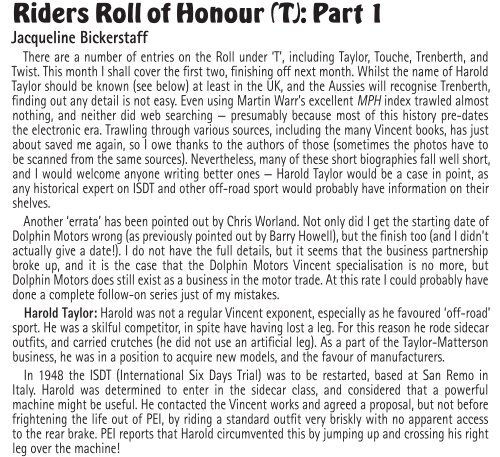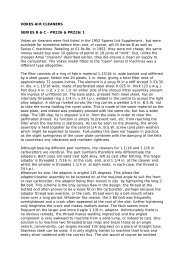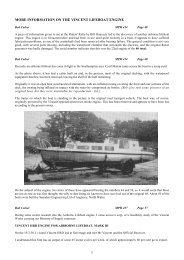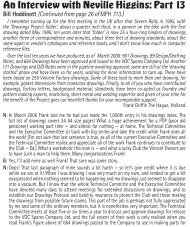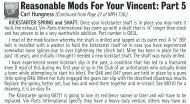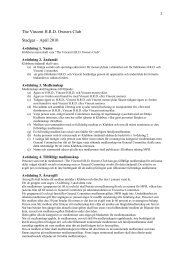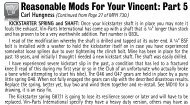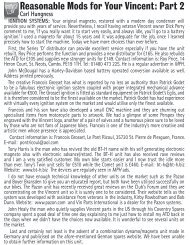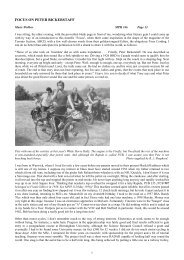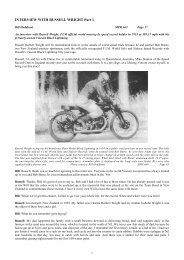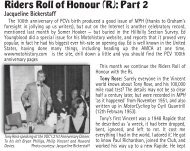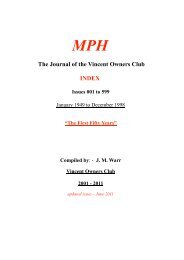Riders Roll of Honour (T): Part 1 - Vincent HRD Owners Club
Riders Roll of Honour (T): Part 1 - Vincent HRD Owners Club
Riders Roll of Honour (T): Part 1 - Vincent HRD Owners Club
- No tags were found...
You also want an ePaper? Increase the reach of your titles
YUMPU automatically turns print PDFs into web optimized ePapers that Google loves.
<strong>Riders</strong> <strong>Roll</strong> <strong>of</strong> <strong>Honour</strong> (T): <strong>Part</strong> 1Jacqueline BickerstaffThere are a number <strong>of</strong> entries on the <strong>Roll</strong> under ‘T’, including Taylor, Touche, Trenberth, andTwist. This month I shall cover the first two, finishing <strong>of</strong>f next month. Whilst the name <strong>of</strong> HaroldTaylor should be known (see below) at least in the UK, and the Aussies will recognise Trenberth,finding out any detail is not easy. Even using Martin Warr’s excellent MPH index trawled almostnothing, and neither did web searching — presumably because most <strong>of</strong> this history pre-datesthe electronic era. Trawling through various sources, including the many <strong>Vincent</strong> books, has justabout saved me again, so I owe thanks to the authors <strong>of</strong> those (sometimes the photos have tobe scanned from the same sources). Nevertheless, many <strong>of</strong> these short biographies fall well short,and I would welcome anyone writing better ones — Harold Taylor would be a case in point, asany historical expert on ISDT and other <strong>of</strong>f-road sport would probably have information on theirshelves.Another ‘errata’ has been pointed out by Chris Worland. Not only did I get the starting date <strong>of</strong>Dolphin Motors wrong (as previously pointed out by Barry Howell), but the finish too (and I didn’tactually give a date!). I do not have the full details, but it seems that the business partnershipbroke up, and it is the case that the Dolphin Motors <strong>Vincent</strong> specialisation is no more, butDolphin Motors does still exist as a business in the motor trade. At this rate I could probably havedone a complete follow-on series just <strong>of</strong> my mistakes.Harold Taylor: Harold was not a regular <strong>Vincent</strong> exponent, especially as he favoured ‘<strong>of</strong>f-road’sport. He was a skilful competitor, in spite have having lost a leg. For this reason he rode sidecaroutfits, and carried crutches (he did not use an artificial leg). As a part <strong>of</strong> the Taylor-Mattersonbusiness, he was in a position to acquire new models, and the favour <strong>of</strong> manufacturers.In 1948 the ISDT (International Six Days Trial) was to be restarted, based at San Remo inItaly. Harold was determined to enter in the sidecar class, and considered that a powerfulmachine might be useful. He contacted the <strong>Vincent</strong> works and agreed a proposal, but not beforefrightening the life out <strong>of</strong> PEI, by riding a standard outfit very briskly with no apparent accessto the rear brake. PEI reports that Harold circumvented this by jumping up and crossing his rightleg over the machine!
Sidecar side view <strong>of</strong> the Taylor ISDT <strong>Vincent</strong>, as appearingin PCV’s 50 years <strong>of</strong> the Marque’ (Roy Harper/<strong>Vincent</strong>Publishing Company).Photo courtesy: Jacqueline BickerstaffPhil Irving already had experience <strong>of</strong> ISDTmachine preparation (at Velocette, who hadsupplied Stuart Waycott’s machines pre-war)which was very special. The machine was basedon a Black Shadow spec. engine built by DenisMinett, and carried the usual extras and toolsin the sidecar and retained by rubber bands (eg.compressed air cylinders). A right-hand brakepedal was fitted, and brackets for the crutches.In view <strong>of</strong> the strenuous conditions expectedthe suspension was stiffened by putting a thirdspringbox between the normal two rear ones. Aspare wheel was carried on the sidecar, whichcould be closer coupled than normal due tothe missing controls. The machine has beendescribed as carrying seven sprockets, but apicture suggests that each wheel may have carried just one, which would have been a choice<strong>of</strong> four sprockets. It is not clear when the decision was made to use the Girdraulic fork, PEIsuggests that he waited until two pairs had been fitted to works hacks (his sidecar and Ted Davies’solo) and found satisfactory. However, it was an ideal opportunity to test them under arduousconditions, and furthermore the construction made it easy to assemble a specially wide set, usingspacers, so that four fully interchangeable wheels could be used. Taylor’s <strong>Vincent</strong> was thus thefirst to be built and supplied with Girdraulics.The whole outfit must have been quiteheavy, and to modern eyes not an ideal trialsmount, but the specialist trials lightweightshad yet to develop and courses reflected this.A <strong>Vincent</strong> Twin, and sidecar must have been ahandful, especially for Taylor with only one leg.Nevertheless he came through the competitionto win a bronze medal (as did S.F. Board on asolo <strong>Vincent</strong> Twin!). For this result, in such amajor international competition, at a time when<strong>Vincent</strong> were in the process <strong>of</strong> establishing theirpost-war reputation, Harold Taylor is recordedon the <strong>Roll</strong> <strong>of</strong> <strong>Honour</strong>.Harold Taylor did not keep the ISDT <strong>Vincent</strong>,and competed in the 1949 ISDT on the newHarold Taylor’s <strong>Vincent</strong> sidecar outfit was based on aBlack Shadow engine (but not black), and was the firstbike supplied with girdraulic forks. Four interchangeablewheels were used, all with sprockets. One-legged HaroldTaylor rode this machine in the San Remo based ISDT, towin a bronze medal!Photo courtesy: Jacqueline Bickerstaffshaft-drive Sunbeam. His outfit was bought by long-time VOC member Franz Moldenhauer, whoplanned to campaign it in the 1949 ISDT (and who may have been similarly ‘disabled’?). It wasretained in Norway by Franz until his death, although by this time in pieces, and passed to hisson. It is believed to be still there, awaiting rebuild.Rodney Touche: Rodney was a very active Member in the early days <strong>of</strong> the <strong>Club</strong>, butrelatively little is recorded, and his placement on the <strong>Roll</strong> <strong>of</strong> <strong>Honour</strong> is in part due to personalrecommendation <strong>of</strong> the <strong>Club</strong>’s late Founder, Alan Jackson, who knew and valued his contribution.The entry is also unusual, in that it was earned by both racing and road exploits.For the road riding part, Rodney’s recorded exploit was a tour <strong>of</strong> Europe in 1950, at a timewhen overseas touring was not quite as easy or common as it is today (although not new toRodney himself). Furthermore, it was undertaken in order to ‘chauffeur’ a benevolent Americanaround Europe, the time available being four weeks and the itinerary eventually adding up to6,000 miles. It must have been a tough American to do that on a Series ‘C’ Rapide. Rodney,
however, remembered that the American required a drink when met in Paris, before he actuallysat on the bike! The route then passed down to Geneva, racing with a Bentley, to Milan, whereItalian hotelier Angelo Ticozzi was so overcome by the sight <strong>of</strong> a <strong>Vincent</strong> that he insisted theyfollow him to his garage where he had a team clean the travel stained machine and service it.In Pisa they suffered a puncture and approaching Venice ran into a chicken causing an accident.The Brenner pass provided passage back to Austria, although a train had to be used to passthrough the Javern tunnel into Corinthia. They then proceeded to Germany, and one-time BMWworks rider, Georg Meier’s garage, where a proud BMW R50/2 owning USAAF sergeant wastaught a lesson in fast bikes. Another flat, on the front wheel provided some excitement, andthe front tyre, by this time worn down to canvas, proved difficult to find a replacement for untilAntwerp. The trip then took in Sweden and Denmark, and the Esbjerg ferry, where the Bentleydriver recognised them.Rodney Touche also raced his <strong>Vincent</strong>s, starting in 1951 with a standard Black Shadow, runningon ‘Pool’ petrol (with a bigger main jet and rear sprocket). His 1952 machine had started out asa standard Rapide, but fitted by Jack Surtees with 21” and 20” alloy wheels, Lucas racing mag,and the Black Lightning gears. When Rodney acquired it he replaced the heads, barrels, and T.T.carburettors with a Rapide owner, porting the replacements, fitting new, 32mm T.T. carburettors,and pistons from Alex Phillip’s 1950 T.T. winning bike. He managed a win at Thruxton in the‘unlimited’ race in 1952 amongst his results, and also wrote some advice for racers in MPH(36 and 46), recommending a manual magneto for push starts, Black Lightning gears for quickchanges, and T.T. carburettors.s


